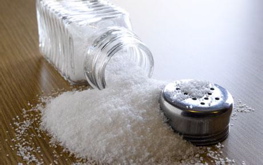 In January 2010, New York City Mayor Michael Bloomberg made headlines by asking for a 25 percent reduction is salt over the next five years. Last week, the New York State Assembly took it a step further with a new piece of legislation that would ban salt from all restaurant cooking completely. Restaurants would be fined up to $1,000 per addition of salt before, during, or after cooking. Of course, this piece of legislation is way too strict and far-fetched and will never pass. However, in Mayor Bloomberg’s latest heath initiative, he has asked restaurants and food companies across the country to voluntarily reduce the salt content in food. Because it’s an issue that is almost impossible to legislate and regulate, the administration and partners in other cities are hoping the public pressure and enticement of positive PR will compel those in the food industry to comply. Companies and restaurants that commit to the targets set by the city have five years to reduce salt in their products and menu items by 25%, a target reached after over 60 talks with officials at huge manufacturers like PepsiCo and Kraft. This is a step in the right direction.
In January 2010, New York City Mayor Michael Bloomberg made headlines by asking for a 25 percent reduction is salt over the next five years. Last week, the New York State Assembly took it a step further with a new piece of legislation that would ban salt from all restaurant cooking completely. Restaurants would be fined up to $1,000 per addition of salt before, during, or after cooking. Of course, this piece of legislation is way too strict and far-fetched and will never pass. However, in Mayor Bloomberg’s latest heath initiative, he has asked restaurants and food companies across the country to voluntarily reduce the salt content in food. Because it’s an issue that is almost impossible to legislate and regulate, the administration and partners in other cities are hoping the public pressure and enticement of positive PR will compel those in the food industry to comply. Companies and restaurants that commit to the targets set by the city have five years to reduce salt in their products and menu items by 25%, a target reached after over 60 talks with officials at huge manufacturers like PepsiCo and Kraft. This is a step in the right direction.
As was the case with Bloomberg’s smoking and trans fat bans and calorie count requirements, some are exclaiming nanny state, while others praise the move as progressive. The National Salt Institute, of course, is not happy as they are quite cheerful while making money on the slow poisoning of America.
The Health Department Announces Proposed Targets for Voluntary Salt Reduction in Packaged and Restaurant Foods and a new city plan pushes for 25% reduction of salt in nearly all food products
Mayor Michael Bloomberg has become New York City’s nutritional watchdog, banning the use of trans fats, forcing chain restaurants to post calorie counts and exhorting diners to consume less salt. Now he is at it again, directing his campaign at sugary drinks with a new series of attention-getting advertisements that ask subway riders: Are you pouring on the pounds?
During his term as mayor, the city has declared sodium an enemy, asking restaurants and food manufacturers to voluntarily cut the salt in their dishes and encouraging diners to ask waiters for food without added salt. It seems that restaurants are paying more attention to customers wishes regarding less salt. Even in Italy, a country that is known for its liberal use of salt, on the same par with Asian restaurants, actually heeded my plea to avoid salt recently while protestations in the past went unheeded.
It is the salt in processed foods, not in shakers, that poses the greatest health risk.
Most prepared foods are too salty or too sweet as these two basic ingredients are primary and unsophisticated tastes that consumers crave and help to sell the product. Even though the consumer may not taste the saltiness immediately, in a period of time one will feel the result of being very thirsty. Consumers can always add salt to food, but they can’t take it out. At current levels, the salt in our diets poses health risks for people with normal blood pressure, and it is even riskier for the 1.5 million New Yorkers with high blood pressure. If we can reduce the sodium levels in packaged foods and food served in restaurants, we will give consumers more choice about the amount of salt they eat, and reduce their risk of heart disease and stroke in the process.
The recommended daily limit for sodium intake is 1,500 mg for most adults over 40 and blacks (who are prone to hypertension) and 2,300 mg for others. Some food products contain that much sodium in one serving. But much of the salt in Americans’ diets comes from breads, muffins and other foods that don’t taste salty. Salt levels can vary dramatically among popular products in the same category, such as breakfast cereals, indicating that lower levels are both technically feasible and commercially viable.
Other countries are already reducing salt in packaged and restaurant foods. In the United Kingdom, a similar collaboration between the food industry and government has already resulted in salt reductions of 40% or more in some food products, with the overall goal of reducing the salt in processed and restaurant foods by one third. Canada, too, is actively addressing the issue, and Australia, Finland, Ireland, and New Zealand have all launched large scale, countrywide initiatives to help reduce the salt in their foods.
The National Salt Reduction Initiative has received a great deal of support from philanthropists and donors, including the W.K. Kellogg Foundation. Funding for the evaluation of population salt intake was provided by the Robert Wood Johnson Foundation, the New York State Health Foundation, the National Association of County & City Health Officials and the Federal Centers for Disease Control and Prevention.
As for the Mayor, he over salts almost everything, even saltine crackers. He devours burnt bacon and peanut butter sandwiches and likes his popcorn so salty that it burns others lips. At Gracie Mansion, the cooks deliver it to him with a salt shaker. He has a weakness for hot dogs, cheeseburgers, and fried chicken and his favorite snack? Cheez-Its.


 Elaine’s was admittedly not serving the best food in town although, there was always the bar; writers, actors and others in the know congregated at Elaine’s for years, and she and the saloon were so much a part of the New York City scene. She controlled it with an iron fist, and customers today must be wondering if it will be able to survive without her.
Elaine’s was admittedly not serving the best food in town although, there was always the bar; writers, actors and others in the know congregated at Elaine’s for years, and she and the saloon were so much a part of the New York City scene. She controlled it with an iron fist, and customers today must be wondering if it will be able to survive without her. ★ Culinary Tidbits . . . After reflecting on renowned New York French chef Daniel Boulud’s recent remark to the Miami Herald after being asked the question, What is the worst thing you have ever eaten? He replied, “Raw chicken liver very late at night at a yakitori place in Tokyo. From the minute I put it in my mouth I knew it would be a challenge to keep it down.”
★ Culinary Tidbits . . . After reflecting on renowned New York French chef Daniel Boulud’s recent remark to the Miami Herald after being asked the question, What is the worst thing you have ever eaten? He replied, “Raw chicken liver very late at night at a yakitori place in Tokyo. From the minute I put it in my mouth I knew it would be a challenge to keep it down.”

 After a two year absence, kangaroo is back on the menu in New York even though there are few restaurants outside of Eight Mile Creek, an Australian themed restaurant in Manhattan, that features it. Only a certain species from Tasmania is still banned. With an estimated 60 million kangaroos (macropod marsupials) in Australia there is little danger of extinction, and it is the only truly organic, free-range food on the market.
After a two year absence, kangaroo is back on the menu in New York even though there are few restaurants outside of Eight Mile Creek, an Australian themed restaurant in Manhattan, that features it. Only a certain species from Tasmania is still banned. With an estimated 60 million kangaroos (macropod marsupials) in Australia there is little danger of extinction, and it is the only truly organic, free-range food on the market. Culinary Tidbits . . . This month celebrity Italian chef Mario Batali has launched his new bi-monthly Viaggio Magazine along with editor Bob Guccione Jr., although unlike some of his peers he has chosen to excluded it from the newsstands and keep it strictly in-house.
Culinary Tidbits . . . This month celebrity Italian chef Mario Batali has launched his new bi-monthly Viaggio Magazine along with editor Bob Guccione Jr., although unlike some of his peers he has chosen to excluded it from the newsstands and keep it strictly in-house.
 In January 2010, New York City Mayor Michael Bloomberg made headlines by asking for a 25 percent reduction is salt over the next five years. Last week, the New York State Assembly took it a step further with a new piece of legislation that would ban salt from all restaurant cooking completely. Restaurants would be fined up to $1,000 per addition of salt before, during, or after cooking. Of course, this piece of legislation is way too strict and far-fetched and will never pass. However, in Mayor Bloomberg’s latest heath initiative, he has asked restaurants and food companies across the country to voluntarily reduce the salt content in food. Because it’s an issue that is almost impossible to legislate and regulate, the administration and partners in other cities are hoping the public pressure and enticement of positive PR will compel those in the food industry to comply. Companies and restaurants that commit to the targets set by the city have five years to reduce salt in their products and menu items by 25%, a target reached after over 60 talks with officials at huge manufacturers like PepsiCo and Kraft. This is a step in the right direction.
In January 2010, New York City Mayor Michael Bloomberg made headlines by asking for a 25 percent reduction is salt over the next five years. Last week, the New York State Assembly took it a step further with a new piece of legislation that would ban salt from all restaurant cooking completely. Restaurants would be fined up to $1,000 per addition of salt before, during, or after cooking. Of course, this piece of legislation is way too strict and far-fetched and will never pass. However, in Mayor Bloomberg’s latest heath initiative, he has asked restaurants and food companies across the country to voluntarily reduce the salt content in food. Because it’s an issue that is almost impossible to legislate and regulate, the administration and partners in other cities are hoping the public pressure and enticement of positive PR will compel those in the food industry to comply. Companies and restaurants that commit to the targets set by the city have five years to reduce salt in their products and menu items by 25%, a target reached after over 60 talks with officials at huge manufacturers like PepsiCo and Kraft. This is a step in the right direction.
